You might be wondering if you need to caulk your baseboards. After all, it’s a lot of work – and if you don’t do it right, you could end up with an ugly mess on your hands. In this article, we’ll answer some common questions about caulking baseboards and provide tips on how to do it properly. We’ll also discuss when it’s necessary to varnish them and when it’s not. So read on for all the information you need to make an informed decision about whether or not to caulk your baseboards!
Protect Your Baseboards’ Beauty and Longevity
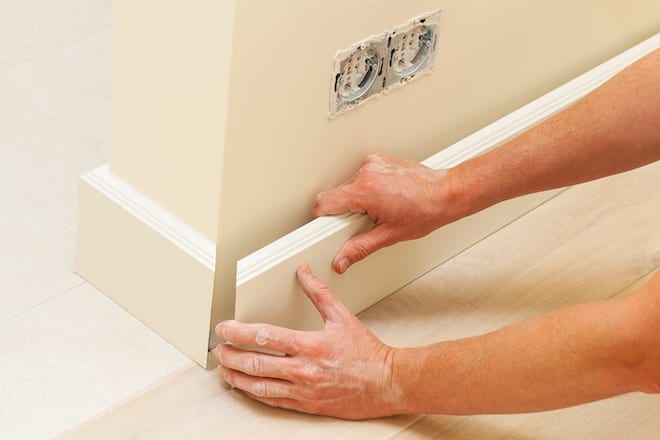
Caulking baseboards is not only a great way to protect your investment, but it also provides many benefits. For instance, caulking:
- Keeps water from seeping behind the baseboard and causing damage
- Prevents drafts from coming in through gaps between the baseboard and the floor
- Reduces noise transmission between rooms
- Makes it easier to clean the baseboard (since dirt and dust won’t be able to accumulate in the cracks)
All of these factors can contribute to the longevity of your baseboards. In other words, caulking them is a smart move if you want them to last for years (or even decades) to come.[1]
To Protect Against Water Damage
If you live in an area with high humidity, or if your home is prone to leaks, caulking your baseboards can help protect against water damage. Water can seep through cracks and cause mold and mildew to grow, which can damage your walls and lead to expensive repairs.
Caulking can also help insulate your home by sealing off any gaps where air might be escaping. This will keep your home warmer in the winter and cooler in the summer, helping you save on energy costs.[1]
To Protect Against Insect Infestation.
One of the main reasons to caulk your baseboards is to prevent insects from entering your home. Insects are attracted to gaps and cracks in homes, and caulk provides a barrier that they can’t penetrate. If you live in an area with a lot of insects, caulking your baseboards is a good way to keep them out of your home.[1]
Weigh the Pros and Cons
Whether you should caulk baseboards or not is ultimately a personal decision. Some people feel that caulking gives their home an extra layer of protection against dirt, dust, and other debris. Others believe that caulking is unnecessary and simply creates more work in the long run. There are pros and cons to both sides of the argument, so it’s important to weigh them carefully before making a final decision.
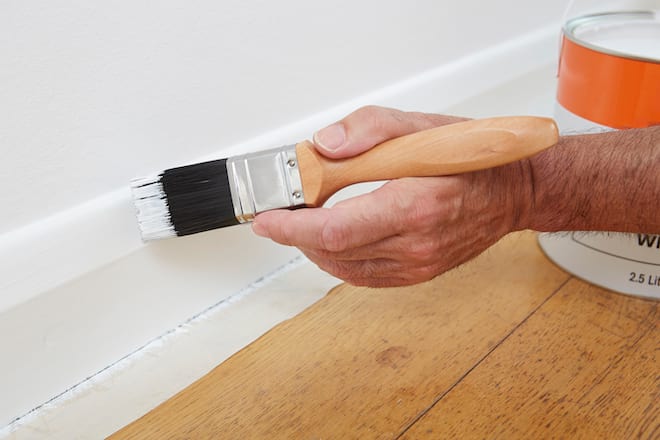
On the plus side, caulking does provide an additional barrier against dirt and dust. If your home is prone to these types of problems, caulking can help to reduce the amount of cleaning you’ll need to do. Additionally, caulking can also help to prevent water damage by filling in any gaps that might allow moisture to seep in.
On the other hand, caulking can be difficult to apply evenly and can sometimes look messy. It also needs to be replaced periodically as it wears down over time. If you’re not comfortable with the idea of regularly maintaining your caulking, it might not be the best option for you.
At the end of the day, the decision of whether or not to caulk baseboards is a personal one. There are pros and cons to both sides of the argument, so it’s important to weigh them carefully before making a final decision.[1]
DIY a Perfectly Finished Look
Should you caulk baseboards? The answer may surprise you. Baseboards are one of those finishing touches that can really make or break the look of a room. And while most people think they need to be varnished, the truth is, caulk is often a better option.
Caulk has a few advantages over varnish. First, it’s more flexible, so it’s less likely to crack or chip over time. Second, it’s easier to apply evenly, so you won’t end up with brush strokes or drips. Finally, caulking your baseboards will help seal out dust and dirt, making them easier to clean in the long run.[1]
How to Caulk Baseboards
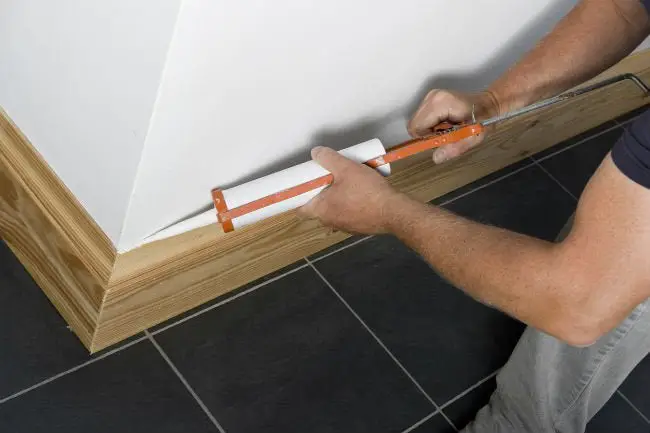
What You’ll Need
To caulk baseboards, you’ll need:
- Caulking gun
- Silicone or latex caulk
- Putty knife
- Rag or paper towel
- Mild detergent (optional)
- Water (optional)
If your baseboards are painted, you’ll also need:
- Paintable caulk
- Caulk primer (optional)
Choose the right caulk.
The type of caulk you’ll need depends on the material your baseboards are made of. If they’re made of painted wood, use a clear or white silicone caulk. If they’re made of bare wood or another type of material, like metal or ceramic tile, use a paintable acrylic caulk.
Now that you know whether you should caulk your baseboards and what kind of caulk to use, it’s time to learn how to apply it. Read on for helpful tips on caulking like a pro![2]
Prep the baseboards with painter’s tape.
Caulking baseboards is an easy way to improve the look of your home and protect it from water damage. However, before you start caulking, there are a few things you need to do to prepare the baseboards. First, use painter’s tape to mask off any areas that you don’t want caulking on. This will help ensure a clean line and prevent any accidental caulking.
Next, use a putty knife or similar tool to remove any old caulk or paint that is on the baseboards. This will ensure that the new caulk adheres properly and doesn’t have any problems gripping onto the surface.[2]
Load the caulk gun.
If you’re using a caulking gun, load it with the tube of caulk. Cut the tip of the caulk tube at a 45-degree angle, making sure that the cut is no bigger than the width of the joint you’re trying to fill.[2]
Apply the caulk.
Use a caulking gun to apply the caulk. The tip of the caulk tube should be cut at a 45-degree angle. Apply the caulk in a steady stream, moving the caulking gun along the length of the baseboard.
Fill all gaps with caulk, then use your finger or a putty knife to smooth it out. Wipe away any excess caulk with a damp cloth.
Let the caulk dry for at least 24 hours before painting or staining it. You can speed up the drying time by using a hairdryer on a low heat setting.[4]
Smooth the bead before it dries.
You can use your finger, a putty knife, or a caulk tool to smooth the bead of the caulk. Make sure to smooth the caulk in the direction you want it to go so that it doesn’t end up too thick in one spot.
Once you’ve smoothed out the bead of caulk, remove any excess with a damp cloth.[2]

Peel back the painter’s tape.
Admire your work for a moment then start peeling away the painter’s tape. If you used FrogTape, you shouldn’t have any bleed through or seepage. If you did get some paint on the wall, no worries! A little touch up with a brush should do the trick.
Now stand back and admire your new-looking baseboards! Caulking them was well worth the effort and they look great.[2]
Where and How to Apply Caulk to Baseboards
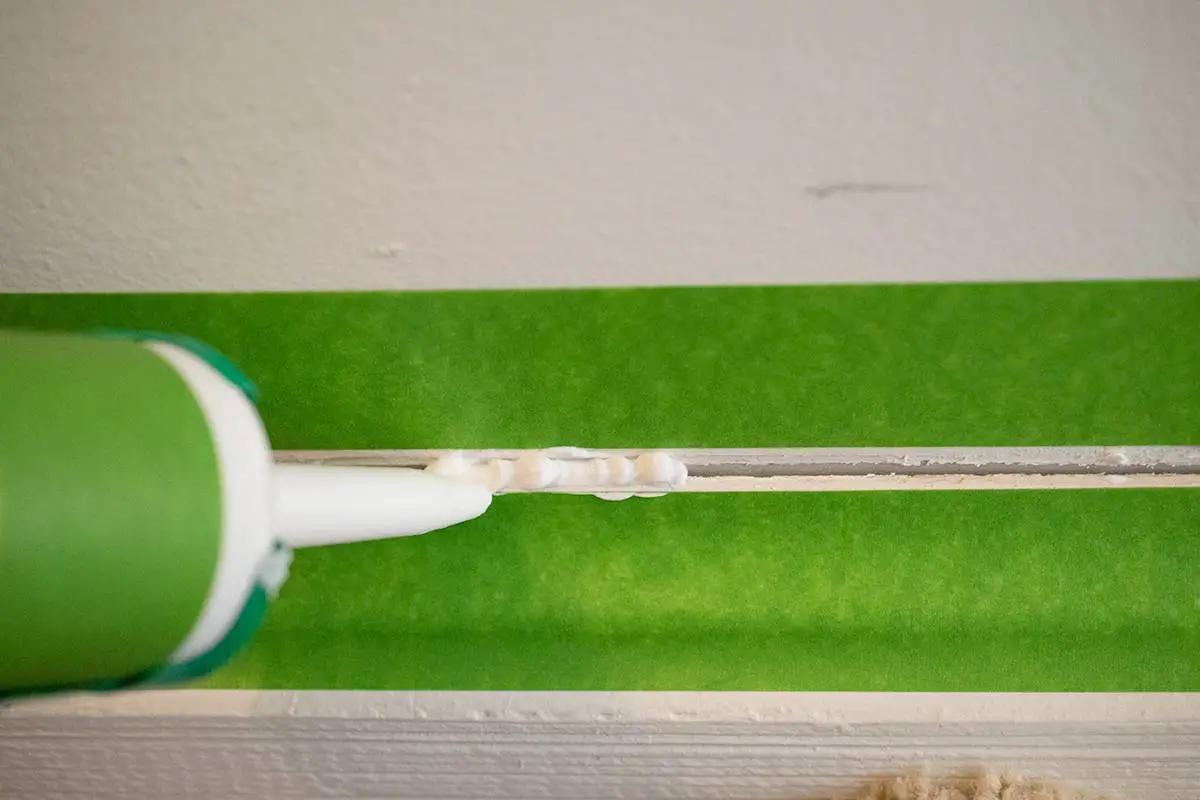
If you have decided that your baseboards need caulking, the next step is to determine where and how to apply the caulk. In general, caulk should be applied:
- At the joint between the wall and floor
- Along doorways
- At any other points where two pieces of trim come together
- Wherever else there are gaps or cracks in your trimwork[1]
Use the Appropriate Type of Caulk
Latex Caulk
Latex caulk is a water-based product that is easy to apply and clean up. It is also paintable, so it can be used on both painted and unfinished wood surfaces. However, latex caulk can shrink over time and may need to be replaced sooner than other types of caulk.[3]
Acrylic Latex Caulk
Acrylic caulk is a good middle ground between latex and silicone caulks. It is paintable, mildew-resistant, and easy to apply and clean up. Acrylic caulk can also be used on both painted and unfinished wood surfaces. However, like latex caulk, it can shrink over time.[3]
Siliconized Acrylic Latex Caulk
Silicone caulk is a more durable option that can withstand extreme temperatures and humidity. It is also waterproof, making it ideal for use in bathrooms, kitchens, and other areas where moisture is present. However, silicone caulk can be more difficult to apply and remove than latex caulk.
No matter which type of caulk you choose, be sure to read the label carefully before purchasing to make sure it is suitable for your needs.[3]
Never combine different kinds of caulk
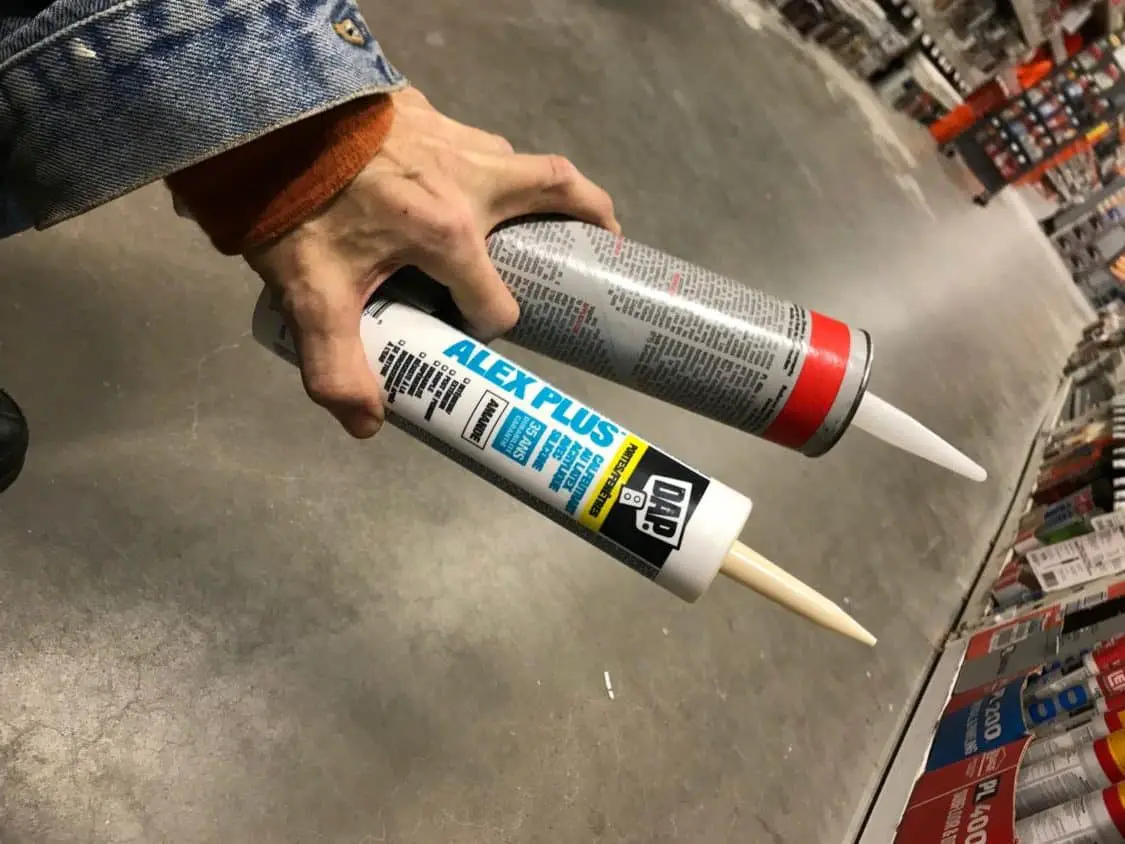
For example, don’t use silicone caulk with latex caulk. The two materials are not compatible and will not adhere to each other properly.
Applying caulk can seem like a daunting task, but it’s actually quite simple. Just follow these easy steps and you’ll be an expert in no time![3]
Use a Wet Rag
To avoid making a mess, you can use a wet rag to smooth out the caulk or a caulking tool. If you’re using a wet rag, make sure that the area is well-ventilated so that the fumes don’t overwhelm you. And if you’re using a caulking tool, be careful not to apply too much pressure or you’ll end up with an uneven finish.
Either way, once you’ve finished applying the caulk, give it 24 hours to cure before painting over it or otherwise touching it. This will give the caulk time to set and create a strong bond.[3]
Caulk Color
When choosing a color for your caulk, select something that closely matches the color of your baseboards. This will help the caulk blend in and create a seamless look.
There are also clear caulks available, which can be a good option if you’re not sure what color to choose or if you want the caulk to be as invisible as possible.
Keep in mind that paintable caulks can yellow over time, so if you’re going for an ultra-clean look, opt for a non-paintable caulk.
And finally, make sure to read the labels on your chosen caulk before purchasing it. Some caulks are only meant for indoor use while others can be used both indoors and outdoors.[1]
Always Prepare Your Working Area
The first step is always to prep your working area. This means protecting the floors and any furniture in the room where you’ll be caulking. We suggest using drop cloths or old towels to catch any drips or accidental smears. You should also open any windows in the room to ventilate the space and protect yourself from fumes.
Next, remove all of the baseboard covers from their respective nails or screws. If possible, label each piece as you remove it so that you can easily put them back in their rightful place later on. Once everything is removed, use a vacuum cleaner with a soft brush attachment to clean up any dirt or debris that might be on the surface of the baseboards themselves.[3]
Caulking Baseboards: Making Informed Decisions
The question of whether to caulk baseboards is a common one among homeowners seeking to improve their home’s appearance and energy efficiency. Below, we delve into the considerations surrounding caulking baseboards, discussing reasons, benefits, application, potential drawbacks, and situations where caulking may or may not be the best choice for your home.
| Aspect | Information |
|---|---|
| Reasons to Caulk | Caulking baseboards can create a finished look, seal gaps, prevent drafts, and enhance energy efficiency. |
| Benefits | Caulking offers a polished appearance, improved insulation, reduced dust infiltration, and potential savings on heating and cooling. |
| Application | Caulking baseboards involves applying a line of caulk along the seam between the baseboard and the wall, then smoothing it for a neat finish. |
| Drawbacks | Improper caulking or using the wrong type of caulk can lead to unsightly results or make future repairs challenging. |
| Situations to Consider | Caulking is especially useful in older homes with gaps, uneven walls, or visible cracks between baseboards and walls. |
| New Construction | For new construction, caulking baseboards can offer a clean look and aid in preventing air leaks. |
| Decorative Molding | When dealing with decorative molding or historic details, caulking may not be appropriate to maintain the authenticity of the space. |
| DIY vs. Professional | While caulking is a DIY task, consulting professionals can ensure optimal results, especially for complex situations. |
| Painting Considerations | Caulking before painting can provide a seamless finish, but it requires careful application to avoid paint adhesion issues. |
| Maintenance | Regular inspection and maintenance are essential to address any caulk deterioration or gaps that may develop over time. |
Explanation of the Table:
- Reasons to Caulk: Lists the purposes for caulking baseboards.
- Benefits: Explores the advantages of caulking baseboards.
- Application: Describes the process of caulking baseboards.
- Drawbacks: Mentions potential drawbacks of improper caulking.
- Situations to Consider: Highlights scenarios where caulking is particularly beneficial.
- New Construction: Discusses the role of caulking in new construction.
- Decorative Molding: Considers situations where decorative molding impacts caulking decisions.
- DIY vs. Professional: Compares DIY caulking with professional assistance.
- Painting Considerations: Explains considerations when caulking before painting.
- Maintenance: Emphasizes the importance of ongoing maintenance.
By understanding the ins and outs of caulking baseboards, you can make informed choices that enhance your home’s aesthetics and efficiency.
FAQ
Is caulking trim necessary?
Caulking isn’t strictly necessary, but it can help to prevent drafts and moisture damage. If your baseboards are already in good condition, you may not need to caulk them.
How do you know if you need to caulk? A simple way to test is to run your hand along the trim. If you feel any gaps, then caulking is a good idea.
Another reason to caulk is for aesthetics. Caulking can give your baseboards a neater appearance and help them blend in with the rest of the room.
Should I caulk baseboards before I paint?
This is a common question, and there are a few things to consider before making a decision. If your baseboards are old and cracked, caulking them before painting will help create a smooth surface. However, if your baseboards are in good condition, you may not need to caulk them.
Another thing to consider is the type of paint you’ll be using. If you’re planning on using a water-based paint, caulking isn’t necessary since this type of paint doesn’t require an extra sealant. On the other hand, if you’re using an oil-based paint, caulking can help create a barrier between the paint and the wall so that the paint doesn’t soak into the wall.
Where do you caulk baseboards?
The answer to this question depends on a few factors. If your baseboards are made of wood, then you’ll want to caulk any gaps between the trim and the wall. You may also want to caulk around windows and doors where the trim meets the frame.
If your baseboards are made of PVC or another type of material, then you may not need to caulk at all. However, it’s always a good idea to check for gaps and fill them if necessary.
What type of caulk is best for baseboards?
There are a few types of caulk that can be used for baseboards, but the best type is acrylic latex caulk. This type of caulk is easy to apply and will last a long time. It is also paintable, so you can easily match it to the color of your walls or trim.
Another type of caulk that can be used for baseboards is silicone caulk. Silicone caulk has many benefits, including being waterproof and mold resistant. However, it can be difficult to apply and remove, so it’s not the best option for beginners.
Do I need to caulk baseboards in the bathroom?
One of the most common questions we get asked is whether baseboards in the bathroom need to be caulked. The answer is yes, you should caulk your baseboards in the bathroom.
The reason for this is that bathrooms are high moisture areas and caulking helps to seal the gaps between the baseboard and the wall, preventing water from seeping in and causing damage.
If you have tile floors in your bathroom, you may also want to consider using grout instead of caulk as it is more resistant to mold and mildew.
Why would you consider caulking baseboards?
Caulking baseboards serves to create a seamless and finished look, enhance the appearance of the room, prevent drafts, and keep out dust and insects from gaps along the baseboard and wall.
Is caulking baseboards a necessary step in home maintenance?
Caulking baseboards is not strictly necessary, but it can provide aesthetic and practical benefits. It’s particularly recommended if you want to achieve a more polished appearance and improve energy efficiency in your home.
What are the advantages of caulking baseboards before painting?
Caulking baseboards before painting helps create clean lines and a professional finish. It conceals gaps and cracks, prevents paint from seeping into crevices, and improves the overall appearance of the room.
Where are the common areas to caulk baseboards?
Common areas to caulk baseboards include the joint where the baseboard meets the wall and the joint where the baseboard meets the floor. These areas are prone to gaps and cracks that can accumulate dirt and affect the overall appearance.
What type of caulk is recommended for caulking baseboards?
For caulking baseboards, a paintable latex caulk is commonly recommended. It adheres well, can be painted over, and provides flexibility to accommodate slight movements in the wood due to changes in temperature and humidity.
How do you properly caulk baseboards?
To caulk baseboards, start by cleaning the area and ensuring it’s dry. Apply a thin bead of caulk along the joint where the baseboard meets the wall and floor. Use a caulk gun and a caulk smoothing tool to create a neat, even line. Wipe away excess caulk and let it dry before painting if desired.
Can caulking baseboards help with soundproofing?
Caulking baseboards can provide a small degree of soundproofing by sealing gaps that allow sound to travel between rooms. However, for significant soundproofing, additional measures such as installing acoustic insulation or using heavy curtains might be more effective.
Do you need to caulk baseboards in every room?
Caulking baseboards is not a requirement in every room, but it’s a good practice in areas where you want a polished finish and improved energy efficiency. Consider caulking baseboards in rooms with noticeable gaps or where dust and drafts are a concern.
Can caulking baseboards help with preventing pest infiltration?
Yes, caulking baseboards can help prevent pests from entering your home through gaps along the baseboard and wall. Sealing these gaps can reduce potential entry points for insects and other pests.
Is it possible to caulk baseboards in humid environments?
Yes, you can caulk baseboards in humid environments. However, ensure that the surfaces are clean and dry before applying caulk. Additionally, choose a caulk that is suitable for humid conditions to ensure proper adhesion and longevity.
Useful Video: Why You Should Caulk Baseboards & Trim Work
Conclusion
So, should you caulk baseboards? In general, the answer is yes – caulking can help to prevent drafts and air leaks, as well as improve the overall look of your trim. However, there are a few exceptions where caulking may not be necessary or even desirable. If you’re unsure, it’s always best to consult with a professional contractor or painter who can assess your individual situation and offer guidance. Thanks for reading!
References
- https://www.homereference.net/should-you-caulk-baseboards/#
- https://www.bobvila.com/articles/how-to-caulk-baseboards/
- https://drillwarrior.com/are-baseboards-supposed-to-be-caulked/
- https://www.thespruce.com/solution-to-caulking-baseboards-3972518














Leave a Reply